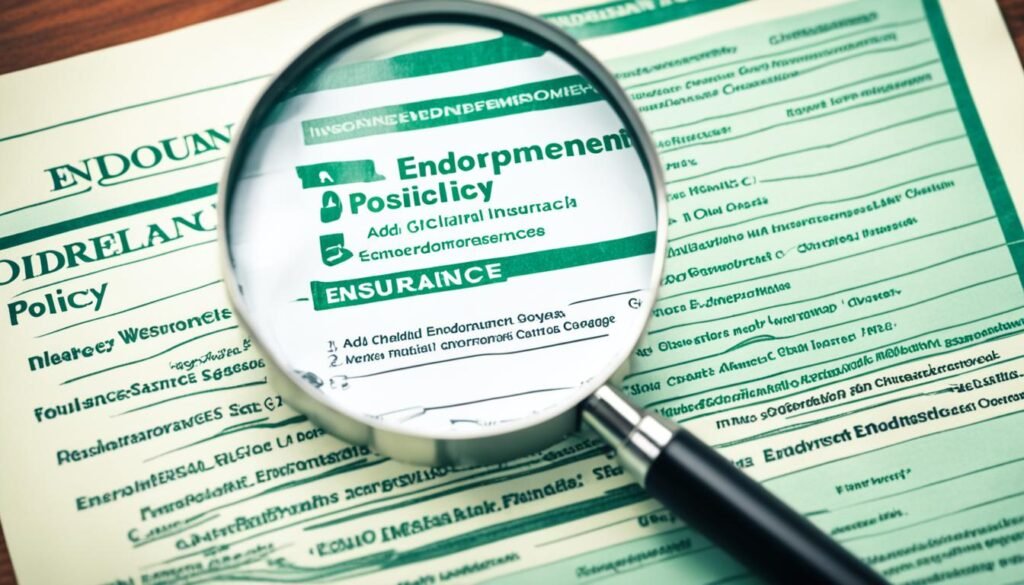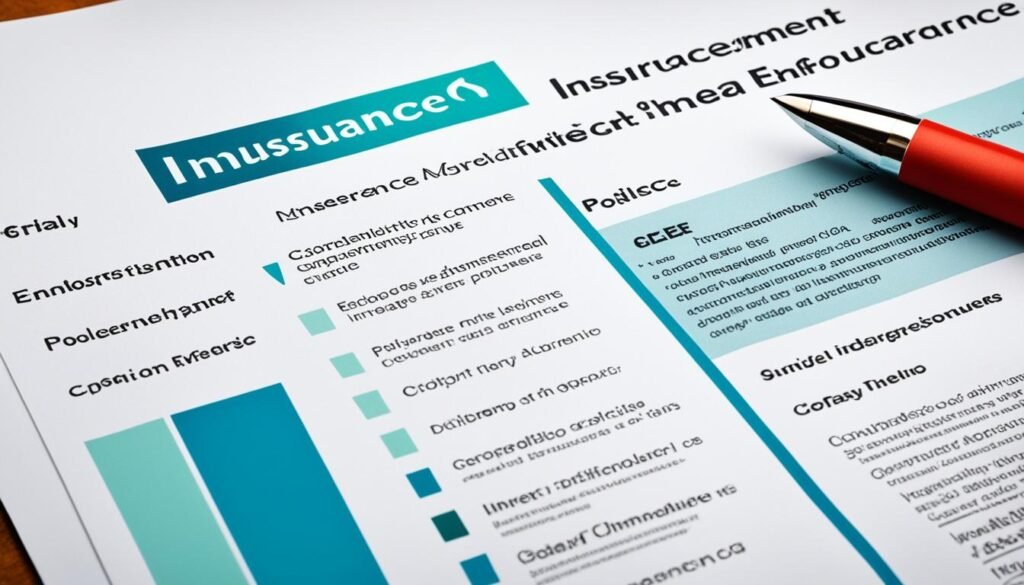When it comes to insurance policies, one size doesn’t necessarily fit all. That’s where insurance endorsements, also known as insurance riders, come into play. These endorsements allow policyholders to customize their coverage, tailoring it to their specific needs and circumstances.
An insurance endorsement is a legally binding change to an insurance policy. It can involve adding or subtracting coverage, changing addresses or names, or altering policy terms. By opting for an endorsement, policyholders have the flexibility to modify their policies and enhance their protection.
Are you curious to know more about insurance endorsements and how they work? Keep reading to explore the ins and outs of this important insurance option.
Key Takeaways:
- An insurance endorsement, also known as an insurance rider, allows policyholders to customize their coverage.
- Endorsements can involve adding or subtracting coverage, changing addresses or names, and altering policy terms.
- Insurance endorsements modify existing policies and can impact the monthly premium and deductible.
- There are four main types of insurance endorsements: standard endorsements, nonstandard endorsements, mandatory endorsements, and voluntary endorsements.
- Examples of insurance endorsements include scheduled personal property endorsement, flood endorsement, earthquake endorsement, additional insured endorsement, and home business endorsement.
What Is an Insurance Endorsement?
An insurance endorsement, also referred to as an insurance rider, is a modification to an insurance policy that adjusts or customizes coverage. It allows policyholders to add or subtract coverage options, change policy terms, or enhance their existing policy to meet their specific needs.
Endorsements can be used to extend coverage, limit or exclude coverage, add or remove people or locations, and can be added at the time of purchase or during the contract term.
Insurance endorsements provide policyholders with the flexibility to tailor their insurance policies according to their personal requirements. By modifying their coverage, policyholders can ensure that their policy addresses their specific risks and provides the appropriate level of protection.
“An endorsement allows policyholders to customize their insurance policies to meet their specific needs and preferences.”
Policy customization is an essential aspect of insurance endorsements. This process involves making adjustments, additions, or exclusions to the policy to align with the policyholder’s unique circumstances. Whether it’s increasing coverage limits, adding additional protection for specific items, or excluding coverage for certain risks, insurance endorsements enable policyholders to fine-tune their policies.
For example, a homeowner may choose to add an endorsement for flood coverage in an area prone to flooding, even if it’s not included in a standard homeowner’s insurance policy. Similarly, a business owner may opt to add an endorsement to address specific liability concerns related to their operations.
Endorsements can be incorporated into both new insurance policies and existing ones. They can be requested at the time of purchasing insurance or added later during the policy term. Policyholders can work closely with their insurance agent or provider to determine the appropriate endorsements that align with their coverage needs.
Overall, insurance endorsements provide policyholders with a valuable tool to customize their policies and ensure adequate coverage. By leveraging endorsements effectively, individuals can tailor their insurance to address their unique risks, enhance protection, and achieve peace of mind.
How Does an Insurance Endorsement Work?

Insurance endorsements play a crucial role in modifying existing policies and tailoring coverage to individual needs. When policyholders require a change in their coverage, an insurance endorsement is the solution. This section will explore the mechanisms behind insurance endorsements and how they impact policy terms and coverage.
Insurance endorsements operate by overwriting and updating the original policy. They take precedence over the original terms and conditions, effectively nullifying outdated information. Instead, endorsements include specific changes requested by the policyholder, ensuring that the policy accurately reflects their desired coverage adjustments.
Endorsements offer the flexibility to modify coverage in various ways. For instance, they can add new coverage by increasing limits or providing additional protection for specific items or situations. This allows policyholders to have the necessary coverage for valuable assets or specific risks they may face. Conversely, endorsements can also limit coverage by removing certain types of coverage from the policy. This might be done to exclude coverage for hazards that are deemed unnecessary or irrelevant to the policyholder’s needs.
It’s important to note that when an endorsement modifies coverage, it can impact the premium and deductible of the policy. Adjustments in coverage, whether increasing or limiting it, can have an impact on the policyholder’s financial obligations. Therefore, it’s essential for policyholders to consider the potential cost implications before requesting changes in their coverage.
How Do Policyholders Modify an Existing Policy?
Policyholders who wish to modify their existing insurance policies can do so by adding an endorsement. To initiate this process, policyholders should contact their insurance agent or provider. Whether it’s adding new coverage or adjusting existing terms, the insurance agent will guide policyholders through the necessary steps and ensure that the endorsement is correctly added to the policy.
The endorsement becomes a part of the policy amendment, documenting the specific changes made to the coverage. By communicating their needs and desired modifications, policyholders can ensure that their policies are tailored to suit their unique circumstances.
Impact of Insurance Endorsements
Insurance endorsements have a direct impact on coverage and policy terms. By customizing coverage to meet policyholders’ specific needs, endorsements provide peace of mind and ensure that important assets or risks are appropriately protected. However, it’s crucial for policyholders to review their policies after any amendments to fully understand the extent and limitations of their coverage.
Next, we’ll explore the different types of insurance endorsements and how they cater to varying policyholder requirements.
Types of Insurance Endorsements

Insurance endorsements come in various types, each serving a specific purpose. Understanding the different types can help policyholders make informed decisions regarding their coverage. There are four main categories of insurance endorsements: standard endorsements, nonstandard endorsements, mandatory endorsements, and voluntary endorsements.
Standard Endorsements
Standard endorsements are the most commonly requested modifications to insurance policies. These endorsements typically involve straightforward changes that many policyholders may require. Some examples of standard endorsements include:
Name or address modifications: Changes to personal information that affect the policyholder’s coverage.
Sewer backup coverage: Adding coverage for damages caused by sewer backups.
Earthquake coverage: Extending coverage to protect against damages caused by earthquakes.
Standard endorsements often have set guidelines or pre-approved terms, making them simpler to process and implement.
Nonstandard Endorsements
Nonstandard endorsements are tailored to unique situations and require specially drafted documents or changes to standard templates. These endorsements address specific circumstances that may not be covered by standard policies. Nonstandard endorsements can vary significantly, depending on the policyholder’s needs. These endorsements are typically customized and require additional consideration and approval from the insurer.
Mandatory Endorsements
Mandatory endorsements are required by law and vary based on the state and specific insurance requirements. These endorsements are designed to ensure policyholders have essential coverage that aligns with legal obligations. The types of mandatory endorsements can differ depending on the insurance policy type and the jurisdiction in which the policyholder resides.
Voluntary Endorsements
Voluntary endorsements are not mandated by law but can be added at the request of the policyholder or insurer. These endorsements provide further customization options for policyholders to meet their specific needs. Voluntary endorsements can enhance coverage, add additional protection, or exclude specific risks based on the policyholder’s preferences.
Summary
Understanding the different types of insurance endorsements is crucial for policyholders who want to tailor their coverage to their specific needs. Standard endorsements are commonly requested and address common changes, while nonstandard endorsements cater to unique situations and require more customization. Mandatory endorsements fulfill legal requirements, and voluntary endorsements provide additional flexibility. Analyzing the options and consulting with an insurance agent can help policyholders make informed decisions when considering endorsements.
Examples of Insurance Endorsements

Insurance endorsements provide policyholders with the flexibility to customize their coverage to suit their unique needs. Here are some common examples of insurance endorsements:
- Scheduled Personal Property Endorsement: This endorsement adds coverage for valuable items such as jewelry, artwork, or collectibles. It ensures that these items are adequately protected in case of loss, theft, or damage.
- Flood Endorsement: This endorsement provides coverage for damages caused by floods. It is particularly important for homeowners living in flood-prone areas to consider this endorsement, as standard home insurance policies typically do not cover flood-related losses.
- Earthquake Endorsement: This endorsement extends coverage to include damages caused by earthquakes. It offers financial protection in the event of property damage or loss due to seismic activity.
- Additional Insured Endorsement: This endorsement extends coverage to individuals or entities other than the primary policyholder. By adding an additional insured, such as a landlord or contractor, the policyholder ensures that the additional party is protected under their insurance policy.
- Home Business Endorsement: This endorsement provides coverage for a small business operated from the policyholder’s home. It protects against potential liabilities, such as accidents or injuries that may occur on the premises.
These examples highlight the versatility of insurance endorsements, allowing policyholders to enhance their coverage and address specific risks or needs. By considering these endorsements, policyholders can customize their policies to provide the necessary protection for their unique circumstances.
How to Request an Insurance Endorsement

When you need to modify your insurance policy or add specific coverage options, requesting an insurance endorsement is a straightforward process. Whether you want to add an endorsement to an existing policy or include one when purchasing a new policy, there are a few simple steps you can follow to ensure your coverage meets your specific needs.
- Contact your Insurance Agent: To request an insurance endorsement, start by reaching out to your insurance agent or provider. They are the experts in the field and can guide you through the process of adding an endorsement to your policy.
- Directly Communicate Your Request: If you already have an existing policy, contact your insurance agent directly to discuss the changes or additions you want to make. Clearly communicate your desired modifications and provide any necessary documentation. This direct communication ensures that your message is received accurately and reduces the chances of miscommunication.
- Inquire During Enrollment: If you are purchasing a new policy, take the opportunity to inquire about available endorsements during the enrollment process. Ask your insurance agent about any additional coverage options or policy modifications that may be relevant to your specific situation. This way, you can customize your coverage right from the start.
Remember, effective communication between you and your insurance agent is crucial when requesting an insurance endorsement. By clearly expressing your needs and providing accurate information, you can ensure that the endorsement aligns with your desired coverage modifications.
What to Include in Your Request
When requesting an insurance endorsement, make sure to include the following details to help your insurance agent process your request accurately:
- The specific changes or modifications you want to make to your policy
- The effective date for the endorsement
- Any supporting documents or information required for the endorsement
- Your full contact information for easy communication
Make sure to double-check the accuracy of the information in your endorsement request. Errors or omissions can result in delays or potential issues with your coverage.
By providing all the necessary information and communicating your needs clearly, you can streamline the process of adding an insurance endorsement to your policy.
| Pros of Requesting an Insurance Endorsement | Cons of Requesting an Insurance Endorsement |
|---|---|
| Allows you to customize your policy to fit your specific needs. Provides added peace of mind by ensuring adequate coverage. Can be added to an existing policy or included when purchasing a new policy. | Premiums may increase depending on the type of endorsement. Modifications may result in changes to policy terms or conditions. Some endorsements may require additional documentation or qualifications. |
Why Insurance Endorsements Matter

Insurance endorsements play a significant role in ensuring that policyholders can modify their insurance policies to match their specific needs and customize their coverage effectively. With the ability to add or remove coverage options, limit or exclude certain types of coverage, and make administrative edits or clarifications, endorsements offer policyholders the flexibility they require to tailor their policies.
The importance of insurance endorsements lies in their legal ramifications and the impact they can have on coverage and claims. Once an endorsement is added to an insurance policy, it becomes part of the legally binding agreement between the policyholder and the insurer. This means that any modifications made through an endorsement are legally enforceable and can affect the policy’s terms and conditions.
Insurance endorsements give policyholders the power to modify their policies, customize their coverage, and ensure they have the appropriate level of protection.
By allowing policyholders to customize their coverage, insurance endorsements enable individuals to align their policies with their unique needs and circumstances, ensuring they have the appropriate level of protection in place. Whether it’s adding coverage for specific risks or excluding coverage that is not relevant, endorsements empower policyholders to have a policy that fits them like a glove.
It is important for policyholders to understand the significance of insurance endorsements and make educated decisions when considering modifications to their policies. Working closely with their insurance agents or providers, policyholders can explore the available options and evaluate the potential impact of each endorsement on their coverage and premiums. This collaboration ensures that policyholders can make informed decisions that protect their interests and align with their specific insurance needs.
The Value of Customizing Coverage
One of the primary advantages of insurance endorsements is the ability to customize coverage. Policyholders can add or remove coverage options based on their individual requirements, ensuring they are adequately protected against potential risks. By tailoring their policies, individuals can:
- Modify policy deductibles to meet their financial capabilities and risk tolerance
- Extend coverage for specific items or situations that may not be covered by the standard policy
- Exclude coverage for risks that are not relevant to their circumstances
Legal Ramifications of Insurance Endorsements
When policyholders make changes to their insurance policies through endorsements, they need to be aware of the legal ramifications. Endorsements become part of the legally binding insurance contract and can impact coverage and claims. It’s crucial for policyholders to review and understand the terms and conditions of their endorsements, ensuring they comply with all obligations to maintain coverage.
Additionally, policyholders should be aware that any misrepresentation or failure to disclose relevant information during the endorsement process could have legal implications. It’s essential to provide accurate and complete information to the insurer when requesting an endorsement to maintain the integrity and validity of the policy.
| Policyholder Actions | Legal Ramifications |
|---|---|
| Failure to comply with endorsement terms and conditions | Disqualification of coverage for claims related to the endorsed changes |
| Misrepresentation or non-disclosure of relevant information during the endorsement process | Voiding of the policy or denial of claims |
Policyholders should consult their insurance agents or legal advisors to better understand the legal implications associated with insurance endorsements and ensure they comply with all regulations and requirements.
The Benefits of Insurance Endorsements

Insurance endorsements offer policyholders a range of benefits, including tailored coverage and enhanced protection. By adding endorsements to their insurance policies, individuals can customize their coverage to meet their specific needs and ensure they have the necessary protection in place.
One of the key advantages of insurance endorsements is the ability to tailor coverage to suit unique situations. Policyholders can add endorsements that provide coverage for valuable personal property, such as jewelry or artwork. This ensures that these items are protected in the event of loss, theft, or damage.
Additionally, endorsements can offer protection against specific risks. For example, policyholders can add endorsements for flood or earthquake coverage, safeguarding their property against these specific natural disasters. This allows individuals to have comprehensive protection against a wide range of potential hazards.
Another benefit of insurance endorsements is the ability to extend liability coverage. Policyholders can add endorsements that provide additional insured coverage, offering protection to additional individuals under the primary policy. This can be especially valuable for businesses or events where multiple parties may be involved.
Overall, insurance endorsements allow policyholders to create a customized insurance policy that meets their specific needs. By tailoring coverage and adding endorsements, individuals can ensure they have the appropriate level of protection in place, providing peace of mind and financial security.
Key Benefits of Insurance Endorsements:
- Tailored coverage to meet specific needs
- Protection for valuable personal property
- Coverage against specific risks like floods or earthquakes
- Extended liability coverage to additional insured parties
The Process of Adding an Insurance Endorsement

Adding an insurance endorsement to your policy is a straightforward process that involves contacting your insurance agent or provider and requesting the desired changes or additions. By initiating this communication, you can begin customizing your policy to better suit your specific needs and ensure that you have the appropriate coverage in place.
When you reach out to your insurance agent, they will guide you through the process of adding an endorsement to your policy. They will gather the necessary information from you, such as the type of endorsement you want to add and the specific changes you’d like to make to your coverage.
“I recently decided to add an insurance endorsement to my policy, and the process was surprisingly easy. I reached out to my insurance agent and explained that I wanted to enhance my coverage by adding a specific endorsement for my valuable personal property. My agent guided me through the process and ensured that the endorsement was correctly added to my policy. Now, I have the peace of mind knowing that my valuable items are adequately protected.” – Sarah, Policyholder
Once your insurance agent has all the necessary information, they will handle the administrative tasks of adding the endorsement to your policy. This process involves updating your policy documents to reflect the changes specified in the endorsement.
The endorsement becomes a part of the policy amendment, documenting the specific changes made to your coverage. It serves as a legal record of the modifications you have made to your policy and ensures that the changes are implemented correctly.
If you have any questions or concerns during the process of adding an endorsement, don’t hesitate to ask your insurance agent for clarification. They are there to assist you and ensure that you have a comprehensive understanding of the changes being made to your policy.
Next Steps: Documenting the Changes
After the endorsement is added to your policy, it’s essential to review your updated policy documents and familiarize yourself with the changes that have been made. Pay close attention to the details of the endorsement, including any limitations, exclusions, or additional coverages that have been added.
Additionally, keep a copy of the endorsement and the updated policy documents for your records. These documents serve as proof of the modifications made to your policy and can be valuable in the event of a claim or dispute.
By understanding the process of adding an insurance endorsement and actively engaging with your insurance agent, you can ensure that your policy accurately reflects your coverage needs and provides you with the necessary protection.
Insurance Endorsements vs. Insurance Riders

When it comes to customizing insurance coverage, you may come across the terms “insurance endorsement” and “insurance rider,” both used interchangeably to refer to the same concept. An insurance endorsement or rider is a modification or change made to an existing insurance policy.
Both terms, “endorsement” and “rider,” describe the process of tailoring the policy to better suit your specific needs. The primary difference between the two is semantic, with “endorsement” being the more commonly used term.
“Insurance endorsements and insurance riders are essentially the same thing—a change or modification to an insurance policy that allows you to customize your coverage.”
Whether referred to as an endorsement or a rider, the purpose remains the same—to adapt your policy to meet your unique requirements. The modification can involve adding or subtracting coverage options, changing policy terms, or enhancing the existing policy to better suit your specific needs.
Illustrative Example
Suppose you have a homeowners insurance policy, but you also own valuable artwork that exceeds the coverage limits. In this case, you may request an endorsement or rider to add coverage specifically for your valuable artwork. By doing so, you can ensure that your artwork is adequately protected in the event of damage or theft.
| Insurance Endorsement | Insurance Rider |
|---|---|
| Modifies an insurance policy | Modifies an insurance policy |
| Allows customization of coverage | Allows customization of coverage |
| Can add or subtract coverage options | Can add or subtract coverage options |
| Can change policy terms | Can change policy terms |
| Enhances the existing policy | Enhances the existing policy |
As the table demonstrates, both insurance endorsements and insurance riders have the same purpose and function. They offer you the flexibility to modify your insurance policy and customize your coverage according to your specific needs.
Understanding the terminology and the synonymous use of “endorsement” and “rider” can help you navigate conversations with insurance providers and ensure that you can effectively customize your coverage to meet your individual circumstances.
Also Read : Level Term Life Insurance Explained Clearly
Conclusion
Insurance endorsements offer policyholders the flexibility to customize their insurance policies and modify coverage to meet their specific needs. With the ability to add or exclude coverage options, policyholders can tailor their policies to suit their unique situations. By understanding the different types of endorsements and working with an insurance agent, policyholders can ensure that their policies reflect the desired coverage.
Utilizing insurance endorsements allows policyholders to unlock the full potential of their policies and ensure they have the appropriate coverage in place. Whether it’s adding coverage for valuable personal property or excluding specific risks, endorsements provide the necessary customization to meet policyholders’ specific requirements.
It is important for policyholders to be aware of the options available to them and to communicate any desired changes to their insurance agent. By actively managing their policies and utilizing insurance endorsements, policyholders can have the peace of mind knowing that their insurance coverage is tailored to their unique needs.
FAQs
Q: What are insurance endorsements?
A: Insurance endorsements are amendments or additions to an insurance policy that can alter or enhance the coverage provided by the policy.
Q: Why are insurance endorsements important?
A: Insurance endorsements are important because they allow policyholders to customize their coverage to better suit their specific needs or to comply with legal requirements.
Q: How do insurance endorsements affect the cost of insurance?
A: Adding endorsements to an insurance policy can impact the cost of insurance by either increasing or decreasing the premium, depending on the type of endorsement and the added coverage.
Q: Can any type of insurance policy have endorsements added to it?
A: Yes, almost all types of insurance policies, including business insurance, car insurance, and home insurance, can have endorsements added to them to modify the coverage.
Q: What is a common type of endorsement in liability insurance?
A: A common type of endorsement in liability insurance is the endorsement to add an additional insured party to the policy.
Q: How can I add an endorsement to my insurance policy?
A: To add an endorsement to your insurance policy, you can contact your insurance company or agent and request the specific endorsement you want to include.
Q: What are some examples of common insurance endorsements?
A: Some common insurance endorsements include equipment breakdown endorsement, accounts receivable endorsement, and reporting period endorsement.





